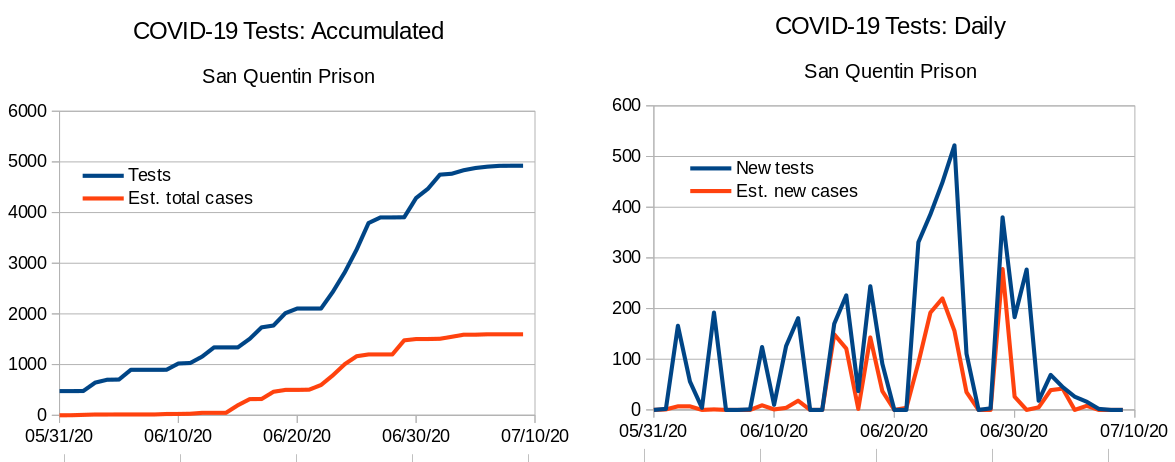
Everyone in my social media circles is mercilessly (and justifiably) mocking Trump for tweeting, with his characteristic semiliterate exclamation mark, “with smaller testing we would show fewer cases!”, and for his push to slow down testing. From the horse’s mouth: “By having more tests, we find more cases. We did 25 plus. 25 million tests. Think of that, 25 million. If you look at other countries—they did one million, two million, three million, big countries—we did 25 million. Way more, by double, triple, quadruple, any other county. Therefore, we test, we’re going to have more cases. By having more cases, it sounds bad. But, actually, what it is is we’re finding people.” So much to pick on, but let’s not waste time on it. It’s the classic (and, in this case, tragic) fallacy: if you don’t see something, it doesn’t mean that it’s not there.
Because the infection, sickness, and death are very real, at yesterday’s press conference, activists, community members, and elected officials indicated several strategies to accomplish a drastic reduction in prison population: focus on the tens of thousands of people deemed “low risk” by CDCR’s own standards; focus on people over 50 (a quarter of the prison population), or even at the thousands of people over 65 (!!!!!) who are incarcerated; commute all death sentences to life with parole and parole those too elderly and infirm to stand a chance; identify all the people with a year or two left on their sentences and let them go, which research solidly confirms does not make a difference in terms of recidivism; rely on the willingness of tens of thousands of families to pick up their loved ones.
Instead, the strategy within prisons seems to have been shifting people around the already-overcrowded facilities. Mother Jones reported:
At first, prisoners who showed symptoms or tested positive were sent to the Adjustment Center, the highest-security unit, where the cell doors are made of solid concrete. Others who needed to be quarantined were sent to Carson, a unit known as “the hole” and typically used to isolate prisoners awaiting disciplinary action. As a result, according to advocates, some prisoners have been refusing to take COVID-19 tests for fear of being put in solitary confinement. People on death row have reportedly refused tests because of concerns that nurses were not changing their gloves. Prisoners know that if they report symptoms, Rudd says, “they’re going to be whisked away to the worst possible place in the universe that they can do their time.”
As the number of sick prisoners skyrocketed, the prison set up air-conditioned tents that could house up to 60 people. More prisoners may be moved into a chapel, according to a recent court filing. On Tuesday, CDCR said it would convert San Quentin’s Prison Industry Authority furniture factory into a 220-bed “alternative care site” to treat COVID-19 patients, and begin implementing 15-minute, point-of-care testing onsite.
For the people who remain inside, those who aren’t sick with the virus are sick with fear. “There’s people just going crazy with anxiety,” Rudd says. “It’s like a horror movie when you’re watching like a monster inch its way towards you and you haven’t no way out, you have nowhere to run. Us being locked in here, it’s like we’re watching this virus get steadily closer to us and there’s nothing we can do.” A group of men who tested positive for COVID-19 and were moved to the Badger unit went on hunger strike last week to protest “dismal” conditions under the lockdown, according to NBC Bay Area.
Madison Pauly, “‘It’s Like a Horror Movie’: Trapped Inside San Quentin During an Explosion of COVID-19, Mother Jones, July 8, 2020
But, as Chad Goerzen and I are finding out by crunching numbers from the CDCR tool, they have also taken a page out of Trump’s pandemic prevention book: They slowed down testing in San Quentin, the epicenter of the prison pandemic. In the graph above, you see a big push in testing in late June shortly after the San Quentin disaster broke into mainstream media. Indeed, a high percentage of the tests came back positive. Even though cases were still rising, around July 3, testing came to a grinding halt–and the few tests that were still coming in were coming in positive. The correlation we found between cumulative testing and cumulative cases is 0.99. The correlation between new testing and new cases is 0.7.
In other words: The more people you test, the more people come out positive. If you’re seeing abatement in the numbers of infected people, it does not necessarily mean fewer infected people. It could mean, and actually does mean, less testing.
This is making me doubt some of the numbers we saw before in places like Avenal and Chuckawalla. The cases dropped, but so did the testing; what if there are still untested folks who are carrying the virus around? With regard to Quentin, this could mean a lot more cases than the already alarming highs we are seeing.
This should go without saying, but apparently these days nothing does, so here goes: Testing is an essential component of pandemic response. Proper isolation and mass release decisions need to be based on facts, not on partial reporting based on what we want to see. It is crucial to conduct systematic testing, with a fast turnaround, at the epicenter of this disease.
In other prison pandemic news, CCI and CRC are seeing an alarming rise in new cases, as well.




1 Comment
[…] report apparent abatement in infections have brought their testing program to a grinding halt. As I explained yesterday, this means we do not have a true sense of where the pandemic is still active. The prisons listed […]